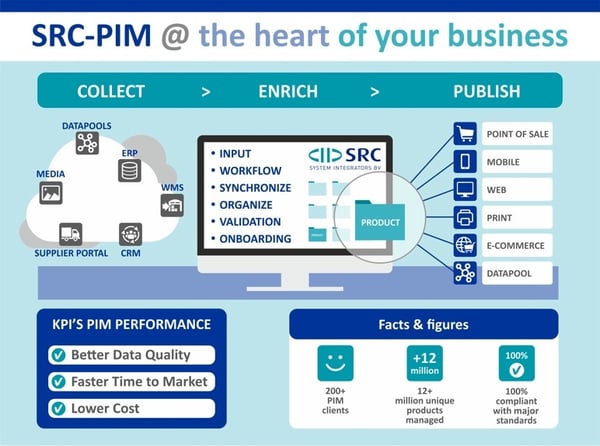Organizations who aim to manage and publish their product data efficiently, usually make use of a PIM-system. With a PIM-system, you have complete control over your product data, and you are no longer depended on different systems. Moreover, a PIM-system optimizes your internal processes, creating value in numerous areas. But how does a PIM-system work?
Collect, enrich and publish
Within an organization, a PIM-system is a core system in which all product information comes together. With a PIM-system, you collect data from other internal systems, enrich this data, and publish this data to all relevant channels (see image 1).
Collect: a PIM-system imports your data and ensures that data is entered in the correct fields in the desired way. By importing data from other internal sources such as the ERP-system, supplier portal or data pool, a single source of truth is created. When you change information, you will only have to change it in one place.
You have two options to import data to your PIM-system. The easiest and the least time consuming is to do this automatically. In this case, your PIM automatically retrieves information from other systems and vice versa. However, this option is also the more expensive one. The other option is to import your data via an Excel file.
Enrich: After importing your data, it is possible to enrich data with additional information so that it complies with data standards such as GS1 or Superunie adam. One of the benefits of managing data with a PIM-system is that you are assured that product data is the same on all channels. This eventually leads to improved data quality as any potential discrepancies between various pieces of information will no longer occur.
Publish: Because all data is up-to-date and present in the PIM-system, data can be published efficiently to all relevant channels. Think of your e-commerce system, the ERP system or a data pool.

How does a PIM-system work with data standards?
More and more organizations and industries work with market standards for product data. This is an efficient way for suppliers to provide their product data to their buyers. But how can you manage your product data according to the requirements set by data standards, such as GS1?
Several PIM-systems enable you to manage, enrich and publish your data to several data standards, such as GS1. However, SRC-PIM is the only PIM-system in the Netherlands that is fully integrated with the GS1 data standard. With the built-in validation functionality, you have real-time insight into your data and if it meets the requirements set by GS1.
Without this functionality, you can only validate your data manually through the web portal of GS1. Uploading your data through the GS1 portal can take up a week before it is checked. When you have entered something wrong, you will need to make changes and upload it again.
How to publish your data to GS1 data standard?
Do you want to know more about SRC-PIM and how it works with GS1? Read our free whitepaper and discover how you can manage and publish your data according to the GS1 standard.